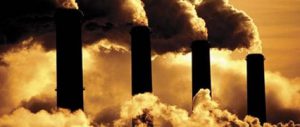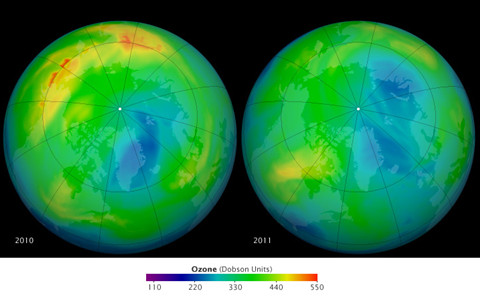The US has been pushing for years to get Chinese support for a global reduction of HFCs under the Montreal Protocol Treaty, originally signed in 1987 to curb the use of ozone-depleting chemicals.
Amending this treaty to include curbs on the production and use of HFCs would eliminate the equivalent of 90 billion tons of carbon dioxide by 2050. The US, Canada and Mexico have submitted a proposed HFC phase-down amendment (the “North American proposal”) at Montreal Protocol meetings every year since 2009. Over 110 countries want to see some sort of HFC proposal move forward, but China, India and Brazil do not, and their objections have kept these discussions from moving forward.
China’s objections have been particularly important because it is a major global manufacturer and exporter of HFCs. Chinese delegations to the Montreal Protocol have offered a variety of legal and diplomatic reasons for why they do not support incorporating HFC phase downs into this treaty. Chinese representatives, for example, often state that since HFCs are greenhouse gases, an HFC phase down is a climate change issue, rather than an ozone-protection issue, and as such it should be discussed under the auspices of the United Nations Framework Convention on Climate Change. Chinese representatives also complain about the uncertainty regarding the price and availability of HFC substitutes.
What has really been happening on the Chinese side is that China’s chemical companies have been lobbying against the Montreal Protocol amendment, and administrative divides between China’s climate and environmental agencies have made it difficult to overcome that lobbying power.
The real story behind China’s sudden pivot on HFCs is much bigger than what has been reported in the press surrounding the Sunnylands summit. While the US has been pushing this issue within the Montreal Protocol over the past few years, major financial and political struggles have been underway in China, and a sudden shift in those struggles is what allowed for this new US-China HFC agreement.
China’s powerful chemical lobby
Two Chinese industries are heavily impacted by the HFC issue: the chemical industry, which produces HFCs and other refrigerants; and appliance manufacturers that produce air conditioners and refrigeration units that utilise those chemicals.
China’s chemical industry has been the biggest barrier to change on HFCs. When China initially agreed under the Montreal Protocol to phase down HCFCs, China’s state-owned chemical companies invested heavily in the research, development, and production of HCFC substitutes, particularly HFCs. Today, those investments are finally starting to pay off, and the chemical companies have no intention of cutting off that lucrative revenue stream.
Sinochem Lantian, a major Chinese state-owned chemical company, now dominates the Chinese market for HFC-134a, an HFC refrigerant used primarily in vehicle air-conditioning systems. Over the past few years, Sinochem Lantian has ramped up HFC production and raked in huge profits. The company’s net profits from HFC-134a and other Montreal Protocol substitutes rose a massive 48 percent between 2010 and 2011, and the company is still building new HFC production facilities. Once those HFC chemical plants are built, they cannot be converted to produce alternative compounds, giving Sinochem Lantian and other Chinese HFC producers a strong incentive to block the international effort to phase down the use of those products.
The China Association of Fluorine and Silicone Industry, or CAFSI, has been a steady presence at Montreal Protocol meetings, and the powerful state-owned chemical companies such as Sinochem Lantian also send representatives to make sure that their objections are voiced. At the last big Montreal Protocol meeting in July 2012, for example, Chinese chemical-industry representatives issued an official statement objecting to any consideration of HFC phase downs under the protocol.
Division stalls China’s progress on HFCs
HFC progress has been made even more difficult in China due to an administrative divide between that nation’s climate change and pollution regulators.
HFCs are a greenhouse gas included in the Kyoto Protocol. From a Chinese regulatory perspective, that means HFC emissions fall under the authority of China’s powerful National Development and Reform Commission, or NDRC, which has a mandate from China’s State Council (the national cabinet) to combat climate change, to regulate greenhouse-gas emissions, and to serve as China’s representative in international climate negotiations under the UNFCCC.
The fact that the NDRC has domestic regulatory authority over HFC emissions is significant because the agency has major policy clout, particularly on economic issues. If any Chinese agency can find a way around the opposition of China’s chemical industry on HFCs, it’s likely to be the NDRC.
The problem for the international discussions on HFC phase downs, however, has been that the National Development and Reform Commission has limited authority over Montreal Protocol negotiations. The Montreal Protocol was formed to address the ozone layer, and in China that issue has long been considered an environmental protection concern, not a climate change issue.
China’s Ministry of Environmental Protection Foreign Economic Cooperation Office, or FECO, heads up China’s delegations to the Montreal Protocol meetings and takes the lead on implementing the Montreal Protocol phase-down plans. FECO’s role has been a problem on the HFC front because, unlike the NDRC, China’s environmental ministry is relatively weak in the political hierarchy.
China’s Environmental Ministry has authority to negotiate phase downs of substances under the Montreal Protocol, but the ministry does not have authority to regulate HFCs within China, and it lacks the political clout to face off against China’s powerful chemical industry.
The end result of this divide has been confusion and stalemate. It is a situation that has allowed the Chinese chemical lobby to basically dictate the nation’s international stance on this issue.
Changing international stance made Chinese progress possible
Over the past few years, however, two changes have contributed to a gradual policy shift within China and, more recently, China’s changing international position on HFCs.
First, international momentum on the HFC issue has finally picked up sufficient speed to change the market prospects for HFCs and the appliances that use them. National-level HFC restrictions are already under discussion in the United States, Japan, and Europe. Some of those discussions are proceeding in fits and starts, but the growing momentum is clear. Even without a Montreal Protocol amendment, many of China’s major export markets are looking increasingly likely to phase down HFCs through some form of national policy action. If these phase downs happen, then Chinese appliance and chemical exporters will have to comply with those new standards, regardless of what happens within China.
Phasing down HFCs on a country-by-country basis has major implications for China’s air conditioning manufacturers and gives that industry a growing incentive to support an international HFC agreement, because standardising an HFC phase down across borders would make those changes easier to predict and adapt to. Progress on the chemical industry side is slower, but once appliance manufacturers start shifting away from HFCs to alternative replacement chemicals, then the Chinese chemical manufacturers will eventually have to shift as well if they want to maintain market share. Once Chinese chemical companies become convinced that a global HFC phase down is inevitable, they will then have a strong market incentive to invest in the next generation of refrigerants instead of building out more HFC production plants.
At the same time that these changes have unfolded internationally, China’s powerful National Development and Reform Commission has begun to increasingly take on HFC emission reduction as a domestic climate change issue. China’s 12th Five Year Plan for Controlling Greenhouse Gas Emissions (2011-2015) includes a mandate from China’s national cabinet to the NDRC to step up domestic efforts to control HFC emissions. According to Chinese chemical-industry experts, in recent months the NDRC has begun sending increasingly strong signals to the nation’s chemical companies that tighter restrictions on HFC emissions are in the pipeline and that continued refusal to discuss potential pathways for an HFC phase down will not be tolerated.
More work still needed: What to watch for going forward
The combination of steady international diplomatic pressure and increasing NDRC leadership on the HFC issue within China has made this new agreement possible, but there is still more work to be done.
Most importantly, we still don’t know whether China will explicitly support the North American HFC phase-down proposal under the Montreal Protocol or whether China will propose some alternative, either under the protocol or in another forum. Due to the internal Chinese administrative divides mentioned above, the only way to get China’s NDRC on board for this new agreement was to draw a clear institutional connection to the UNFCCC, thus the bilateral pledge to “use the expertise and institutions of the Montreal Protocol” while at the same time “continuing to include HFCs within the scope of UNFCCC and its Kyoto Protocol provisions.”
The ideal scenario would be to secure international agreement for a Montreal Protocol HFC amendment as soon as possible—ideally in the form of the North American proposal already on the table—and follow that by incorporating the HFC phase downs into the UNFCCC process so that the countries that make HFC phase-down commitments under the Montreal Protocol get some kind of credit for that action in the context of the UNFCCC negotiations.
To do that, however, the Chinese will need to clarify which agency will be in charge of those Montreal Protocol HFC negotiations: the NDRC or the Environmental Ministry. Ideally that agency will be the NDRC, since it has the authority to administer HFC regulations in China and the political clout to make that happen with the chemical industry. Chinese leaders could also set up a special coordination group under China’s national cabinet to manage this process. Either way, Chinese leaders will need to pave a clear path forward on the administrative process side, and that has not happened as of yet. One thing to watch for on that front will be who sits at the table to represent China, and in what rank order, during the HFC discussions at the Montreal Protocol meeting in Bangkok later this month.
China’s chemical industry can also be expected to try to slow the process. At present, DuPont (United States), Honeywell (United States), and Daikin (Japan) are the primary producers of HFC-replacement chemicals. Chinese chemical companies have some catching up to do if they want to compete in that market, and they are going to want to buy as much time as they possibly can to ensure that they have a chance to gain a sizable market share in the next generation of refrigerants.
This is an edited version of an issue brief originally posted on the Center for American Progress website. Additional credit to Andrew Light.






